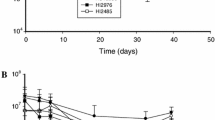Abstract
Background Candida spp., mainlyCandida albicans, are frequently responsible for complications in immunocompromised patients. There are limited data comparing recovery efficiency using simple non-selective basal broth media.
Aim To compare several commercially available basal growth media to determine the medium that gave highest yeast proliferation.
Method Eight commercially available non-selective basal broth culture media were evaluated for optimum recovery of clinicalC. albicans andC. glabrata. They included nutrient broth (NB), nutrient broth no. 2 (NB2), Todd-Hewitt (TH) broth, tryptone soya broth (TSB), tryptone soya broth supplemented with yeast extract (0.5% w/v [TSBYE]), brain heart infusion broth supplemented with yeast extract (0.5% w/v [BHIYE]), salt meat broth (SMB) and 0.1% [w/v] peptone saline (PS). Differences in cell density were evaluated by spectrophotometrical analysis.
Results TSBYE>BHIYE>TSB>TH>NB2>NB>SMB>PS for the optimum proliferation of cells in vitro. Either TSBYE or BHIYE broth may be employed as suitable basal broth media for growth ofC. albicans andC. glabrata. NB should be considered the least suitable medium for routine use when others are available.
Conclusion These data may be of value to laboratories setting up simple blood culture systems to detectCandida spp., particularly in developing and underdeveloped countries.
Similar content being viewed by others
References
Fraser VJ, Jones M, Dunkel J, Storfer S, Medoff G, Dunagan WC. Candidaemia in a tertiary care hospital: epidemiology, risk factors, and predictors of mortality.Clin Infect Dis 1997; 15: 414–21.
Pittet D, Wenzel RP. Nosocomial bloodstream infections. Secular trends in rates, mortality, and contribution to total hospital deaths.Arch Intern Med 1995; 155: 1177–84.
McDonald LC, Weinstein MP, Fune J, Mirrett S, Reimer LG, Reller LB. Controlled comparison of BacT/ALERT FAN aerobic medium and BATEC fungal blood culture medium for detection of fungemia.J Clin Microbiol 2001; 39: 622–4.
Eholie SP, N’gbocho L, Bissagnene E et al. Profound mycoses in AIDS in Abidjan (Cote d’Ivoire).Bull Soc Pathol Exot 1997; 90: 307–11.
Lindan CP, Allen S, Serufilira A et al. Predictors of mortality among HIV-infected women in Kigali, Rwanda.Ann Intern Med 1992; 116: 320–8.
Lott TJ, Kuykendall RJ, Reiss E. Nucleotide sequence analysis of the 5.8S rDNA and adjacent ITS2 region of Candida albicans and related species.Yeast 1993; 9: 1199–206.
Author information
Authors and Affiliations
Corresponding author
Rights and permissions
About this article
Cite this article
Moore, J., McMullan, R. Comparison of media for optimal recovery ofCandida albicans andCandida glabrata from blood culture. Ir J Med Sci 172, 60–62 (2003). https://doi.org/10.1007/BF02915247
Issue Date:
DOI: https://doi.org/10.1007/BF02915247




